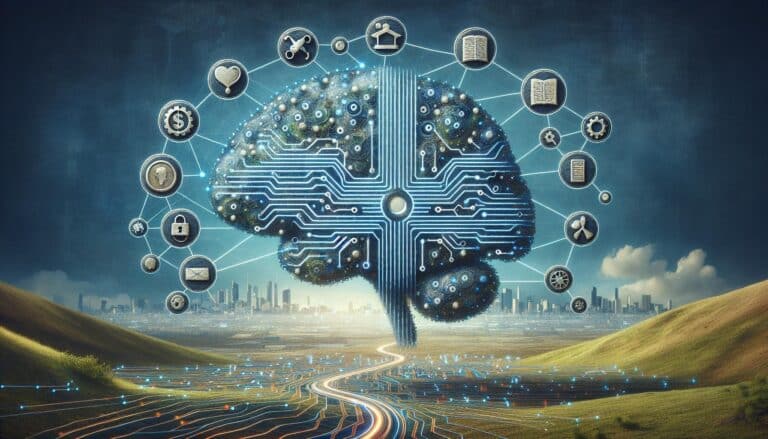Comparing GPT-3 and GPT-4: The Next Big Leap in AI
In the exciting world of artificial intelligence, GPT-3 has been a game-changer. It’s a language prediction model that’s taken natural language processing to a whole new level. But now, there’s talk of GPT-4, and I can’t help but wonder, will it outshine its predecessor?
Both GPT-3 and GPT-4 are products of OpenAI, a leading name in AI research. They’re part of the Generative Pretrained Transformer series, known for their impressive language prediction capabilities. But how do they compare? Is GPT-4 really a step up, or is it hype? Let’s delve into the intriguing battle of GPT-3 vs GPT-4.
PowerBrain AI Chat App powered by ChatGPT & GPT-4
Download iOS: AI Chat
Download Android: AI Chat
Read more on our post about ChatGPT Apps & AI Chat App
Key Takeaways
- GPT-3 and GPT-4 are artificial intelligence language models by OpenAI, both celebrated for their abilities in natural language processing.
- GPT-3 has 175 billion machine learning parameters, making it a powerful tool for understanding and generating human-like text, but it also requires a significant amount of resources to train.
- GPT-3’s significant resource requirements raise questions about AI democratization, as such powerful AI may not be accessible to smaller enterprises and individuals.
- GPT-4 is expected to inherit these strengths and surpass GPT-3 in capabilities, but the computational power required for its development poses a challenge.
- While still in its developmental stage, GPT-4 is anticipated to understand the context better and generate more consistent outputs, addressing some key limitations of GPT-3.
- GPT-4 is also expected to improve in terms of efficiency and response times, making it a potentially superior model for real-time AI applications.
- The exact performance and impact of GPT-4 will only be known upon its official release. Still, its projected capabilities suggest it could redefine AI text generation, bringing us closer to the seamless integration of AI into daily human interactions.
Exploring GPT-3

When we’re talking about GPT-3, the groundbreaking technology by OpenAI, it’s hard not to get excited. It represents a true revolution in artificial intelligence and churns out text that’s so human-like it can take your breath away.
Isn’t it fascinating how it crafts paragraphs, understands context, and even shows a sense of humor? Its capabilities in natural language processing are way beyond our earliest AI dreams. And yet, GPT-3 isn’t just adept at linguistic tasks. It can also answer trivia, write poetry, and even pen its own ideas.
What power this magnificent AI behemoth has! It’s a prime example of transformer-based language understanding models. Using 175 billion machine learning parameters, it simply towers over its predecessor, GPT-2, outgunning it by over 100. The table below provides a brief comparison.
| Parameter | GPT-3 | GPT-2 |
|---|---|---|
| Number of machine learning parameters | 175 billion | 1.5 billion |
Thinking about GPT-3’s size and scale invariably steers us to the question of the raw computing power needed for its creation. The sheer number of parameters and the depth of its learning make it a herculean task to train. It requires enormous resources, which may not be viable for most organizations.
This leads us straight to the heart of the AI democratization debate. With vast resources needed for such innovations, it raises fair questions about the accessibility of such powerful AI to smaller enterprises and individuals. But that’s fodder for another discussion, another time.
As we turn our attention to the upcoming GPT-4, it’s worth pondering how its development will feed off these challenges and opportunities we’ve seen with GPT-3. After all, advancing technology does not simply mean improving; it also means learning from both triumphs and tribulations that come along the way.
Introducing GPT-4

After grasping the remarkable properties of GPT-3, let’s shift our focus to the anticipated successor: GPT-4. Even before its official release, there’s a palpable excitement and curiosity surrounding this ground-breaking AI technology.
As the next iteration in the Generative Pretrained Transformers series, GPT-4 should theoretically inherit GPT-3’s strengths, continuing the tradition of surpassing its predecessor. So, we could look forward to capabilities that are even more astonishing than those of GPT-3. This may comprise tasks never before associated with AI, extending beyond the realm of natural language processing. Remember, GPT-3 already has 175 billion machine learning parameters.
However, the development of GPT-4 isn’t expected to be all smooth sailing. It’s understood that expanding AI capabilities requires immense computational power, which poses a significant challenge. As we discussed in the context of GPT-3, this factor alone may alter the course of AI democratization.
Read more
Chat GPT not working
Chat GPT 3 vs GPT 4
Free GPT 4
Nevertheless, this quest to scale up isn’t simply about maintaining a steady trajectory of improvements. As OpenAI continues refining its AI models, there are crucial lessons being learned. Each progression, each stumble, cultivates an enriching foundation for the evolution of AI.
So, when we think about GPT-4, it’s not just about the technology itself. It’s also about observing the accumulation of knowledge and the lessons learned. Each step is a building block, and as we anticipate GPT-4, we’re also gearing up to embrace the future of AI.
Key Differences Between GPT-3 and GPT-4
As we delve into the core distinctions between these two revolutionary AI models, it’s crucial to acknowledge that GPT-4 is still in its developmental stage. So, any comparisons depend heavily on the anticipated capabilities and improvements based on information available at present.
When it comes to scale and complexity, GPT-4 is projected to be far superior to its predecessor. It’s anticipated that GPT-4 will leverage larger datasets for training, leading to better understanding and generation of human-like text. GPT-3’s limitations in understanding context and producing inconsistent outputs in longer conversations are areas expected to be enhanced in GPT-4.
There’s also talk about GPT-4 showcasing improved interpretability. The lack of explainability has been one of GPT-3’s weaknesses, which sometimes makes its output seem like a ‘black box’. Addressing this limitation will be a significant step forward in AI interpretability, permissions, and safety aspects.
Handling Input and Output Limitations
GPT-3 has a limitation in processing lengthy conversations due to its 2048 tokens limit. A ‘token’ can be roughly thought of as a word, so in practice, the model struggles with texts longer than 2048 words. However, GPT-4 may successfully tackle this challenge, offering deeper, longer, and more meaningful interactions. This ability will be a game-changer in AI-based customer service and other AI-centric conversation platforms.
Enhanced Efficiency and Responsiveness
Increased efficiency and responsiveness are also touted as GPT-4’s standout qualities. It’ll likely be designed to have quicker response times, adding to its usability in real-time scenarios.
In the end, the tangible improvements over GPT -3 will truly prove GPT-4’s worth. Until the model’s official launch, we can only speculate based on the given information. What remains certain is that GPT-4 stands to redefine the AI text generation domain with its ambitious upgrades. It’s an exciting space to watch, filled with immense possibilities.
Performance Comparison

We’re shifting gears to focus solely on performance. If we compare the two, we’ll find noteworthy differences that bring to light the advancements in GPT-4.
To set the context, let’s first look at GPT-3. It shone by producing contextually related outputs, even for complex prompt structures. It’s a performance level that was a quantum leap over older AI models, setting new industry benchmarks. However, it had its share of shortcomings.
GPT-3 sometimes failed to understand the input context, showing linear patterns of coherence. This limitation resulted in less desired outputs, especially when complexity increased. Similarly, GPT-3 often couldn’t explain the reasoning behind its output, something of paramount importance in decision-making mechanisms.
But all signs point to GPT-4 being precisely tuned to conquer these limitations. Let’s shed some light on what we expect with the next version. GPT-4 is designed to bridge the interpretability gap, allowing it to generate and justify outputs.
Let’s not forget about the sheer scale difference. GPT-4 surpasses GPT-3 in its scale, potentially leading to improved performance. With an increase in the dataset size and complexity, GPT-4 stands to gain in learning finer nuances of language, producing coherent, context-aware results.
One particular area where we’re all eager to witness this performance difference is in customer service and conversation platforms. GPT-4’s ability to produce deeper, meaningful interactions is sure to cause a stir in these sectors. The AI community is positively buzzing with anticipation.
The table below presents a simplified comparison between the models:
| Factor | GPT-3 | GPT-4 |
|---|---|---|
| Understanding of context | Limited | Improved |
| Explainability | Limited | Improved |
| Size and complexity | Large | Enormous |
| Use in customer service | Satisfactory | Anticipated to be exceptional |
Looking Ahead: The Future of AI with GPT-4
As we delve deeper into the promise of GPT-4, it’s clear the AI community stands at the precipice of a potentially game-changing era. GPT-4’s immense scale and capacity for complexity are stirring up anticipation.
A key area expected to witness a revolution with GPT-4 is customer service. Let’s consider the time-honored tradition of human interaction in customer service scenarios. Despite the advancement of AI technologies, there’s always been that noticeable “robotic” feel to AI interactions. GPT-4, however, is poised to remove that barrier, bringing a more nuanced understanding of human speech and context into the picture.
GPT-4’s improved performance for conversation platforms is nothing short of a boon. Enabling a smoother, more intelligent interface, these platforms could potentially evolve into organic conversation spaces, blurring the lines between human and AI interaction.
Another exciting aspect is the “Explainability” that GPT-4 is expected to offer. Traditionally, AI models, including GPT-3, have been criticized for being black boxes, churning out results without clear rationalization. GPT-4 seeks to bridge this gap, increasing transparency by offering explanations for its output. This could mark a significant step towards establishing user trust and acceptance if implemented successfully.
It’s important to note that while we’re looking ahead with optimism, GPT-4 still lies in the future. Its real-world performance remains to be seen. Yet, considering its ostensibly promising features, one can’t help but envisage a future where AI seamlessly integrates into daily human interactions.
Conclusion
I’ve explored the potential of GPT-4 and how it’s set to revolutionize AI. Its focus on human-like interactions and context understanding hints at a future where AI is more integrated into our daily lives. The model’s emphasis on “Explainability” is also a game-changer, fostering transparency and trust. While we’re still waiting to see GPT-4 in action, its features are promising. It’s a significant leap from GPT-3, offering a smarter, more engaging interface. So, as we look ahead, it’s clear that GPT-4 is poised to push the boundaries of AI, offering unprecedented capabilities and transforming our interaction with technology.
What is the article about?
This article discusses the anticipated impacts of the GPT-4 AI model on the future of AI, considering its scale, complexity, and potential to mimic human-like speech, understanding, and trustworthiness.
What improvements in customer service is GPT-4 expected to bring?
GPT-4 aims to usher in more human-like interactions, allowing for a better understanding of customer service context and potentially revolutionizing this field of communication.
How could GPT-4 enhance conversation platforms?
GPT-4 is expected to offer users a more intelligent interface that can seamlessly mimic human interaction, blurring the lines between AI and human conversation on various discussion platforms.
What does “Explainability” mean in the context of GPT-4?
Within GPT-4, “Explainability” refers to the model’s focus on making AI decisions and behavior more understandable and transparent to users, aiming to build user trust.
Is the performance of GPT-4 proven yet?
No, the precise performance of GPT-4 is yet to be empirically seen and tested, though it holds significant promise based on its planned features and capabilities.
















